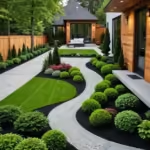Home decoration is an art that transforms a simple space into a personal sanctuary. It involves the careful selection of colors, furniture, accessories, and styles to create an inviting atmosphere. This guide will explore various aspects of home decoration, including color choices, furniture selection, accessories, personal styles, atmosphere creation, and effective decoration tips.
The Importance of Color
Understanding Color Psychology
Colors play a crucial role in home decoration as they can influence mood and emotions. Here are some common associations:
- Warm Colors: Reds, oranges, and yellows can create a cozy and energetic atmosphere. They are often used in living rooms and dining areas to encourage social interactions.
- Cool Colors: Blues, greens, and purples promote calmness and relaxation. These colors are ideal for bedrooms and bathrooms, where tranquility is essential.
- Neutral Colors: Whites, grays, and beiges provide a versatile backdrop that allows other colors to pop. They are often used in larger spaces to create a sense of openness.
Choosing the Right Color Scheme
When selecting a color scheme, consider the following tips:
- Start with a Base Color: Choose a neutral base color for walls and larger furniture pieces. This will create a cohesive look.
- Add Accent Colors: Incorporate one or two accent colors through accessories, artwork, or smaller furniture pieces to add personality.
- Consider Lighting: Natural and artificial lighting can change how colors appear. Test paint samples in different lighting conditions before making a final decision.
Selecting Furniture
Functionality and Style
Furniture selection is vital in home decoration. It should balance functionality and style. Here are some key considerations:
- Purpose: Consider how each room will be used. For example, a living room may require comfortable seating and entertainment options, while a home office needs a functional desk and storage.
- Size: Measure your space to ensure furniture fits well without overcrowding. Scale is essential for creating a harmonious look.
- Style: Choose furniture that reflects your personal style, whether it’s modern, traditional, rustic, or eclectic.
Mixing and Matching
Don’t be afraid to mix different styles and materials. Combining vintage pieces with contemporary furniture can create a unique and personalized look. Just ensure that the overall color palette remains cohesive.
Accessorizing Your Space
The Role of Accessories
Accessories are the finishing touches that bring a room to life. They can add color, texture, and personality. Key accessory categories include:
- Textiles: Rugs, curtains, and throw pillows can introduce patterns and softness to a space. Choose fabrics that complement your color scheme.
- Artwork: Wall art, photographs, and sculptures can serve as focal points. Select pieces that resonate with you and reflect your interests.
- Plants: Indoor plants add a touch of nature and improve air quality. Choose low-maintenance varieties if you’re not a seasoned plant owner.
Layering Accessories
Layering accessories can create depth and interest in your decor. For example, place a large piece of art on the wall, then add smaller frames around it. Use varying heights for plants and decorative objects to create visual balance.
Personal Styles
Identifying Your Style
Your personal style should guide your home decoration choices. Here are some common styles to consider:
- Modern: Characterized by clean lines, minimalism, and a neutral palette. Focus on functional furniture and open spaces.
- Traditional: Emphasizes classic furniture, rich colors, and ornate details. This style often includes heirloom pieces and decorative accents.
- Bohemian: Features vibrant colors, mixed patterns, and a relaxed vibe. It’s all about layering textures and showcasing personal collections.
- Industrial: Incorporates raw materials like metal and wood, with a focus on functionality. Exposed brick and minimalist furniture are common elements.
Creating a Cohesive Look
Once you identify your style, aim for consistency throughout your home. Use similar color schemes, materials, and design elements to create a harmonious environment.
Creating the Right Atmosphere
Setting the Mood
The atmosphere of a home is shaped by various factors, including color, lighting, and furniture arrangement. Here are some tips for creating the right mood:
- Lighting: Use a mix of ambient, task, and accent lighting to create a warm and inviting atmosphere. Consider dimmers for flexibility.
- Furniture Arrangement: Arrange furniture to promote conversation and flow. Avoid blocking pathways and create cozy seating areas.
- Scent: Incorporate pleasant scents through candles, essential oils, or fresh flowers. Scent can significantly enhance the overall atmosphere.
Personal Touches
Adding personal touches, such as family photos or travel souvenirs, can make your home feel unique and welcoming. These elements reflect your personality and create a sense of belonging.
Effective Decoration Tips
Planning and Organization
Before diving into decoration, plan your approach






